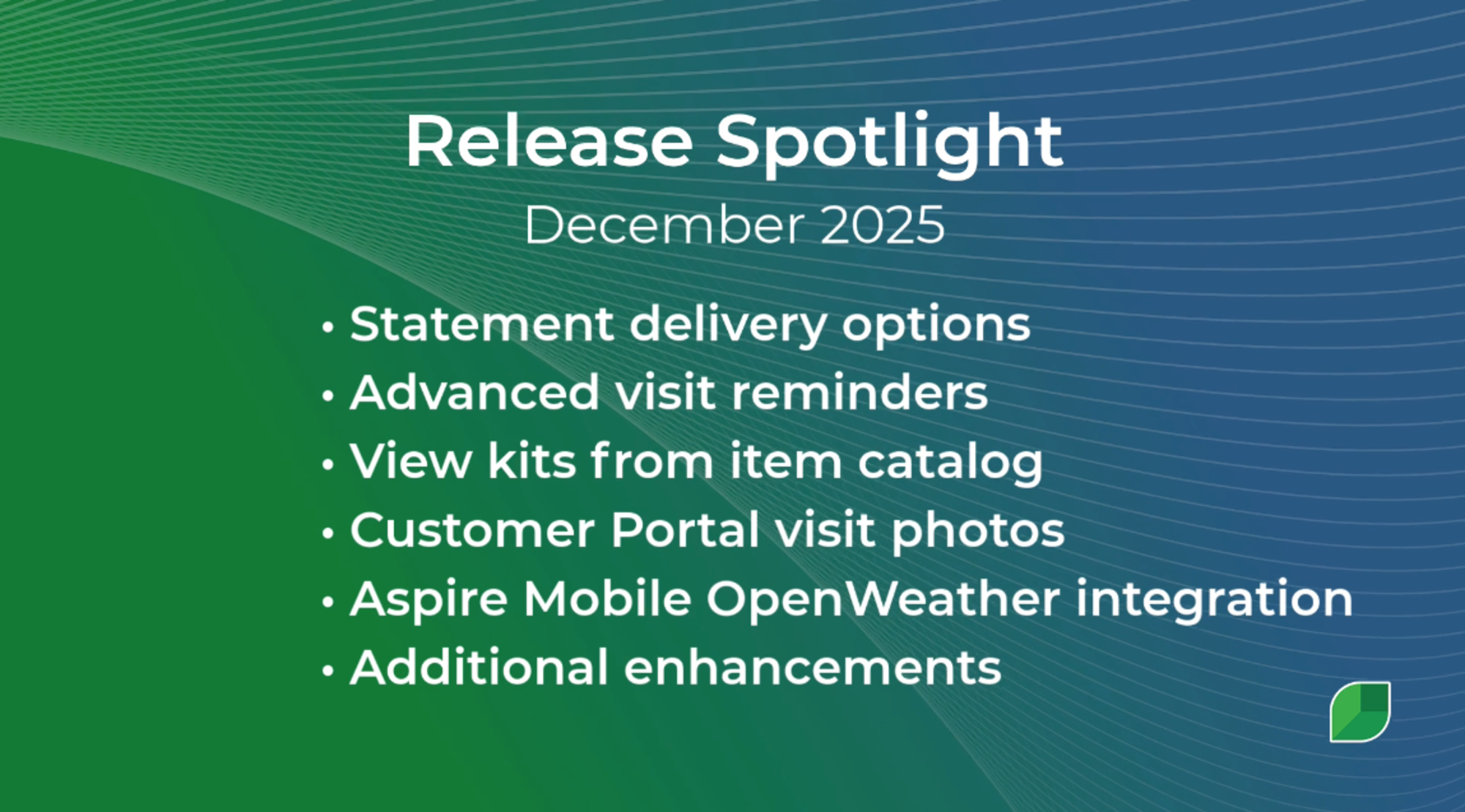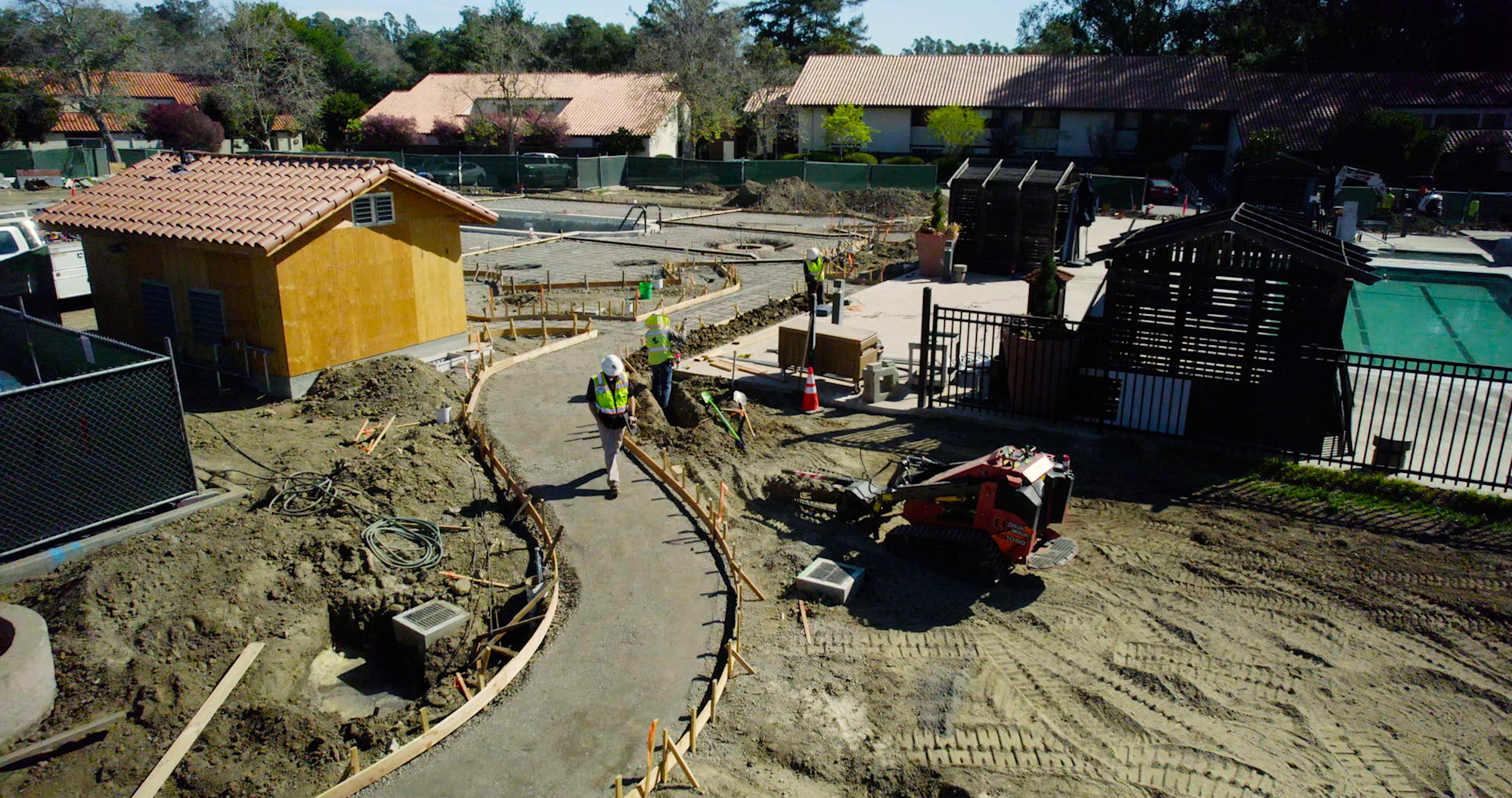Table of Contents
Table of Contents
- The AI Spectrum—What’s What (and Why It Matters)
- Predictive vs. Generative vs. Agentic AI
- Predictive AI analyzes historical data to forecast outcomes.
- Generative AI uses prompts to create new content.
- Agentic AI goes further.
- Where “Chat-Only” Stalls
- Agentic AI in Operations
- Data In, Decisions Out—Why Platform Context Wins
- Centralized Data Beats Disconnected Tools
- Problems with Disconnected Systems:
- Landscaping-Specific Examples:
- Examples from Landscaping Operations
- Crew Routing Intelligence
- Inventory Management Automation
- Equipment Maintenance Optimization
- Practical Differences You’ll Feel in the Office
- From “Assistant” to “Autopilot”
- Before (Assistant Mode):
- After (Autopilot Mode):
- Specific Automation Examples:
- New Management Superpowers
- Exception Management
- Real-Time ROI Analytics
- Capacity Modeling
- Performance Insights
- Current Aspire Capabilities
- Risk, Compliance and Governance—Doing AI the Right Way
- Guardrails and Human Oversight
- Essential controls are:
- Landscaping-Specific Guardrails:
- Human-in-the-Loop Examples:
- Vendor Due Diligence
- Level Up Your Office Ops With Aspire
Imagine a landscaping business owner opening ChatGPT and typing: “Can you schedule my crews for next week?”
Within seconds, they get an answer—but it’s not quite right.
The AI can’t see the company’s calendar, check crew availability, or balance job priorities.
While generative chat tools are cool, they’re limited when it comes to running a business.
Many business leaders have turned to ChatGPT or similar platforms for drafting emails, writing proposals, or brainstorming ideas. These tools are helpful, but they’re just the first step in the AI journey. The real transformation happens when AI moves beyond reactive chat and becomes an agent across your workflows—seeing data, making decisions, and taking action in real-time.
That’s where the magic happens.
Agentic AI can reduce admin hours, streamline scheduling and routing, improve customer communication, and boost overall efficiency.
However, many business owners are hesitant, concerned about complexity, implementation, and ROI.
Meanwhile, industry pressures mean that efficiency and smarter solutions are now more urgent than ever.
The question isn’t if AI will change landscaping, but when.
The AI Spectrum—What’s What (and Why It Matters)
Predictive vs. Generative vs. Agentic AI
Artificial intelligence isn’t a single technology—it comes in forms that serve very different purposes.
Understanding these distinctions helps landscaping leaders envision what’s possible today and what’s on the horizon.
Predictive AI analyzes historical data to forecast outcomes.
In landscaping, this involves predicting when equipment will need servicing based on usage patterns or forecasting seasonal cash flow from past sales data. Predictive systems can also show which services generate the most margin in a particular market so that you can allocate resources better.
It’s not about creating new ideas but seeing the future more clearly through patterns.
Generative AI uses prompts to create new content.
This is the space that most landscaping businesses are already familiar with, thanks to tools like ChatGPT or writing assistants like Claude or Perplexity. Generative AI can draft service descriptions, polish customer emails, or produce marketing copy.
These tools save time and add polish, but are assistants—not in control.
Agentic AI goes further.
It sees the environment, makes decisions, and takes action autonomously. Imagine an AI that automatically reschedules crews when a storm rolls in, prioritizes high-value clients, or identifies sales leads during a call and flags them for follow-up.
Agentic AI doesn’t just assist—it executes.
The difference is critical: predictive informs, generative assists, and agentic acts.
Where “Chat-Only” Stalls
Many landscaping business owners who try ChatGPT quickly discover its limits. The most common frustrations fall into three categories:
Hallucinations: Chatbots often “make up” details. For instance, a generative AI tool might invent client preferences or job details it can’t actually access and give misleading recommendations.
No system context: Generative AI tools can’t see into your CRM, scheduling software, or financial system. It cannot ask when a crew is available on Thursday morning, nor does it have a way to check this information.
No follow-through: Generative AI can suggest the best route, but can’t update your driver’s GPS, notify clients of arrival times, or adjust schedules in real time.
Consider a real-world scenario: a business owner asks ChatGPT to optimize the week’s schedule. After 30 minutes of back-and-forth prompts, they get helpful suggestions.
However, this is followed by manual work, including logging into the scheduling system, updating calendars, calling customers, and notifying crews.
That’s another hour lost.
The AI “helped,” but it didn’t do what was needed.
Generative AI saves time in writing and communication, but its limited access to context and action hinders its usefulness for daily operations.
Agentic AI in Operations
Agentic AI is the next frontier—AI that not only suggests actions but does them. Its strength lies in three core capabilities:
Reads system data: It accesses real-time data from integrated platforms, providing a comprehensive overview.
Triggers tasks: It initiates actions based on rules and conditions, such as weather changes or customer requests.
Closes loops: It completes workflows without human intervention from start to finish.
The impact of landscaping operations is huge:
A severe weather alert automatically reschedules crews, updates customer appointments, and sends notifications.
An equipment maintenance alert not only flags the issue but orders the part and books the technician.
A customer inquiry automatically triggers property measurement, crew assignment, and a draft quote—eliminating the need for manual input.
This is the difference between a digital assistant and a digital operator.
Agentic AI has the potential to reduce administrative bottlenecks, free up staff hours, and deliver a more responsive customer experience.
Note: Agentic AI is not currently a feature of Aspire. Aspire is a comprehensive platform designed to streamline landscaping operations, taking its first steps into providing AI capabilities to users.
Data In, Decisions Out—Why Platform Context Wins
Centralized Data Beats Disconnected Tools
Artificial intelligence is only as good as the data it can access.
Without context, even the most advanced algorithm delivers incomplete or misleading recommendations.
Problems with Disconnected Systems:
Landscaping businesses that use disconnected systems—one for scheduling, another for customer records, a third for equipment tracking—find that AI can’t generate actions across the entire operation.
The problems multiply quickly:
Information silos prevent comprehensive decision-making. A crew scheduling tool may optimize routes without knowing equipment availability or downtime.
Manual data entry creates delays and errors. If maintenance records are updated late, AI models can’t account for the actual condition of equipment.
Lack of context leads to bad recommendations. A customer service chatbot that doesn’t know job history or outstanding invoices risks damaging rather than improving client relationships.
Landscaping-Specific Examples:
In landscaping, context is everything.
Imagine a route optimization tool that schedules four large jobs for one day without factoring in equipment capacity or crew skill sets. Or an AI that drafts a perfect client response but fails to mention their pending invoice or ongoing service plan. Disconnected data doesn’t just slow operations—it erodes trust and efficiency.
When AI is within a unified platform, it can connect the dots across the business.
This is when AI becomes a decision engine—not merely a suggestion engine—one that supports informed, timely, and profitable actions.
Examples from Landscaping Operations
Crew Routing Intelligence
More innovative scheduling is one of the most apparent benefits of AI when it has context.
By combining job locations, traffic patterns, crew skills, and equipment requirements, AI can generate highly efficient routes to minimize travel time, optimize resource allocation, and improve overall productivity.
Inventory Management Automation
Disconnected systems often fail to synchronize material needs with project timelines. AI can change this by tracking materials such as mulch, fertilizers, and plant inventory levels, and automatically generating purchase orders when stock levels are low.
By integrating into job scheduling, materials arrive before crews need them, thereby reducing project delays and last-minute procurement.
By using AI, companies can track materials such as mulch, fertilizers, and plant inventory levels. It can then generate automated purchase orders when supplies are low. Improved material management saves money, prevents disruption, and boosts customer satisfaction through on-time project delivery.
Equipment Maintenance Optimization
Equipment downtime is one of the most considerable hidden costs in landscaping operations. AI can analyze equipment maintenance usage data to predict maintenance needs before a breakdown occurs.
It can also schedule service during crew downtime, order replacement parts in advance, and track warranty and service history across the fleet.
AI can analyze equipment usage data and predict potential maintenance needs. By tying this to crew scheduling, it prevents missed jobs and keeps assets productive for a longer period.
In each case—whether scheduling, inventory, or maintenance—the actual value of AI comes from acting across connected data streams.
A fragmented tool may highlight a problem, but only a platform with a centralized context can deliver complete solutions for landscaping businesses; that’s the difference between AI feeling like an extra task or a game-changer.
Practical Differences You’ll Feel in the Office
From “Assistant” to “Autopilot”
The most tangible impact of AI on landscaping operations is the evolution from assistant mode to autopilot mode. In assistant mode, office staff spend hours every week coordinating across systems. In autopilot mode, AI handles routine tasks in the background, and staff can focus on higher-value work.
Before (Assistant Mode):
An office manager checks the weather forecast.
They manually call each affected customer to reschedule, and crews are assigned one by one.
Routes are updated in GPS systems.
Follow-up confirmations are sent individually.
After (Autopilot Mode):
A weather alert triggers a workflow.
Customers are notified immediately with new dates.
Crews are automatically reassigned and sent to new routes.
Equipment is reassigned based on availability.
Post-completion follow-up surveys are sent automatically.
Autopilot mode significantly reduces the time and effort required for everyday office tasks.
Specific Automation Examples:
Appointment Setting: A customer requests a quote online. The system analyzes the property, assigns a crew, sends a confirmation, and books the job on the calendar—all without staff intervention.
Route Updates: When traffic delays occur, alternative routes are calculated instantly, drivers are updated in-app, and customers are notified of any changes to their arrival times.
Customer Notifications: Upon job completion, customers receive photos, an invoice, and a satisfaction survey.
What took 2-3 hours of manual coordination now takes minutes. The benefit is not only efficiency but a smoother customer experience.
New Management Superpowers
Beyond day-to-day automation, AI delivers what can only be described as new management “superpowers.” Instead of micromanaging details, leaders can focus on strategy, growth, and customer relationships.
Exception Management
With agentic AI monitoring, the operations managers no longer need to watch every task.
They receive alerts only when valid exceptions occur.
For example, suppose a job is running 50% over its estimated time, the system automatically analyzes the causes and suggests corrective actions—whether to adjust crew size, reschedule follow-up work, or flag scope creep for billing.
By catching issues early, AI prevents small inefficiencies from becoming significant profit drains.
Real-Time ROI Analytics
AI also enables continuous profitability tracking across jobs, crews, and service lines.
Aspire already demonstrates the power of centralized data, with comprehensive reporting dashboards that provide precise insights into every aspect of your business. With AI at the forefront, companies can automatically identify their most profitable services, flag underperforming crews, and make real-time adjustments to maximize margins.
Capacity Modeling
Predictive AI enhances scheduling by leveraging historical patterns and current workload. It highlights when resources are near capacity, prevents overcommitting, and identifies underutilised crews or equipment.
For growing businesses, this gives foresight into where to expand without compromising service quality.
Performance Insights
By analyzing crew productivity, AI generates actionable recommendations to improve efficiency. It can correlate customer satisfaction scores with operational metrics to see where delays or miscommunication impact customer perception.
Equipment utilization can also be tracked and optimized, ensuring assets work at peak productivity without overuse.
Current Aspire Capabilities
Aspire has just begun to implement AI capabilities into its end-to-end functionality:
Titan Intelligence for generative AI capabilities in Aspire for writing and refining customer communications, marketing campaigns, and emails.
Scheduling Assistant is an intelligent tool to take the guesswork out of scheduling by analyzing availability, capacity, and conflicts when scheduling crews.
These AI capabilities continue to augment the power of an all-in-one platform:
Real-time dashboards track job costs, profit margins, and overall performance.
Inventory management tools integrate with ordering systems to streamline the material supply process.
Drag-and-drop scheduling offers flexibility, including the option to include blank days for weather-related delays.
Risk, Compliance and Governance—Doing AI the Right Way
Guardrails and Human Oversight
AI in landscaping offices must have boundaries.
Without proper controls, automation can create financial, operational, or safety issues. Guardrails ensure AI complements human judgment, not replaces it.
Essential controls are:
Role-based permissions: Different team members access only the AI functions relevant to their role.
Approval thresholds: High-value or high-risk decisions require human confirmation before execution.
Audit trails: Every AI-driven decision and action is logged for compliance and accountability.
Landscaping-Specific Guardrails:
Major schedule changes require a manager’s approval before being finalized.
Equipment purchases over a certain threshold always need human review.
Customer complaints automatically escalate to human staff.
Any safety-related decision—such as handling hazardous materials or working on steep terrain—must involve the supervision of a qualified individual.
Human-in-the-Loop Examples:
The AI recommends a crew reassignment due to illness, and the manager approves it with a single click.
The system flags a potential safety issue on a job site and alerts the supervisor.
A significant change order triggers automatic escalation to the project manager before proceeding. With these controls, AI adds efficiency without compromising responsibility, transparency, or trust.
Vendor Due Diligence
Choosing an AI partner is not just about features—it’s about governance and long-term reliability. Landscaping businesses must evaluate vendors with the same rigor they apply to financial or safety decisions.
Integration Depth
How seamless is the AI integration with your existing systems? Can it read and write data across various platforms, including scheduling, CRM, and accounting? What are the contingencies when systems are updated?
Product Roadmap Transparency
Vendors should share a clear timeline for planned AI features backed by a track record of delivering on commitments. This demonstrates not only capability but also reliability.
Explainability and Transparency
Can managers understand why the AI made a specific decision? Are audit trails available for compliance checks? How does the system respond to edge cases or unexpected scenarios?
Security and Data Protection
Sensitive business and customer data must be secure. Vendors should have recognized compliance certifications, strong encryption, and thoroughly test AI model updates before deployment.
By applying these standards, landscaping leaders can ensure AI supports—not undermines—their business. The goal is not blind automation but controlled, transparent adoption that strengthens compliance and trust with customers and staff.
Level Up Your Office Ops With Aspire
Artificial intelligence is changing industries everywhere, but you don’t have to wait for tomorrow’s tools to build a stronger business today.
Aspire is the only end-to-end business management platform designed specifically for landscaping contractors, providing you with visibility, control, and efficiency to run at scale.
With Aspire, you can:
Reduce administrative overhead by consolidating scheduling, job costing, and invoicing into one system.
Improve customer satisfaction through proactive communication and real-time updates.
Increase crew productivity with optimized routing and scheduling tools that reduce travel time and maximize daily output.
Gain a competitive edge by transforming operational excellence into a distinct differentiator.
The landscaping industry is moving fast.
Companies that leverage AI successfully will maintain a competitive advantage over their peers across the industry.
Aspire is just beginning to launch AI features in new product releases, empowering customers with these advancements as they mature.
So the question isn't if you should use AI systems, but which AI models will work best for you.
Partner with Aspire and evolve with new technology—without ever having to implement another software system.
Try Aspire today. Book a demo.







